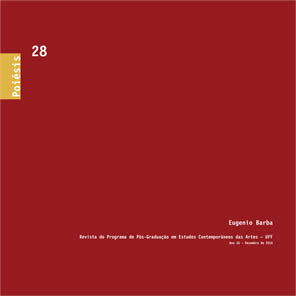O museu é uma fábrica?
DOI:
https://doi.org/10.22409/poiesis.1728.99-114Keywords:
museu, ação política, espaços da arteAbstract
Em 1968, o filme La hora de los Hornos, exibido especificamente em fábricas de forma clandestina, foi um manifesto de grande repercussão do Terceiro Cinema contra o neocolonialismo na América Latina. Nas fábricas, a cada nova exibição, era pendurado um banner que tinha impresso o seguinte texto: “Todo espectador é um covarde ou um traidor”. Sessões de cinema cuja principal intenção era quebrar as distinções entre cineasta e público, autor e produtor, para assim criar uma esfera de ação política. Hoje, filmes políticos não são mais exibidos nas fábricas. Eles são mostrados no museu ou na galeria – no espaço da arte. Ou mesmo, em qualquer tipo de cubo branco. Como isso aconteceu?
Downloads
References
BELLER, Jonathan L, “Kino-I, Kino-World,” in The Visual Culture Reader, ed. Nicholas Mirzoeff ,London and New York: Routledge, 2002.
ElSAESSER, Thomas “The Cinema in the Museum: Our Last Bourgeois Public Sphere?“ In International Film Studies Conference, “Perspectives on the Public Sphere: Cinematic Configurations of ‘I’ and ‘We,’” Berlin, Germany, April 23–25, 2009.
GROYS, Boris, “Politics of Installation,” e-flux journal, no. 2, January 2009.
HABERMAS,Jürgen. The Structural Transformation of the Public Sphere: An Inquiry into a Category of Bourgeois Society, trans. Thomas Burger with the assistance of Frederick Lawrence. Cambridge, MA: The MIT Press, [1962] 1991.
HOLMES Brian, “Warhol in the Rising Sun: Art, Subcultures and Semiotic Production,” 16 Beaver ARTicles, August 8, 2004.
Downloads
Published
How to Cite
Issue
Section
License
Authors who publish in Revista Poiésis agree to the following terms:
- The authors keep the copyright and grant the journal the right of first publication. The work is automatically licensed under the Creative Commons Attribution License, which enables its sharing as long as the authorship and initial publication in this journal are acknowledged.
- Authors are allowed and encouraged to distribute online their work published in Revista Poiésis (in institutional repositories or in their own personal page), since this can generate productive interactions, as well as increase the impact and citation of the published work (See The Effect of Free Access).


